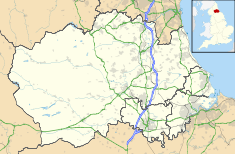- Consett Power Station
-
Consett Power Station Location of Consett Power Station Country England Location Derwentside, County Durham, North East England Coordinates 54°51′00″N 1°50′56″W / 54.850109°N 1.848898°WCoordinates: 54°51′00″N 1°50′56″W / 54.850109°N 1.848898°W Commission date 1903 Decommission date 1980 Operator(s) Consett Iron Company Power station information Primary fuel Coal-fired grid reference NZ098506 Consett Power Station refers to numerous, now demolished coal-fired power stations situated on various sites around Consett in County Durham, North East England.
Contents
History
Knitsley Lane Power Station
In 1903, a small power station was constructed on Knitsley Lane in Consett. It was built and operated by the Cleveland and Durham Supply Company, and generated electricity using two generating sets driven by oil-fueled engines. It supplied electricity over a small area of south west Consett, using an underground cable stretching from the station to Derwent Street. This closed only a couple of years later, in 1906, when the generating sets were removed and the building converted into a substation, providing a step down from 20 kV to 3 kV for local distribution.[1]
Templetown Power Station
The Knitsley Lane station was taken out of operation because of the opening of the Consett Iron Company's own power station. This was situated in the Templetown area of Consett, and was used to supply electricity to the iron and steel works in the town, as well as to local houses. The station was closed in 1961, when electricity supply was provided by the Central Electricity Generating Board.[1]
Central Power Station
Between 1948 and 1955, the Consett Iron Company built the Central Power Station to provide the works with an electricity supply.[1] The large building had two chimneys and two cooling towers. The station was closed along with the steel works in 1980s.
References
- ^ a b c Consett Lions’ Club (December 1963). "The Consett Story". http://members.fortunecity.com/. http://members.fortunecity.com/consett/. Retrieved 5 March 2009.
Electricity generation in North East England Generating
sitesActiveProposed/FutureActiveLynemouth · WiltonClosedBerwick upon Tweed · Blyth · Carville · Chopwell Colliery · Close · Consett · Darlington · Derwenthaugh Coke Works · Dunston · Forth Banks · Hebburn · Horden Colliery · Lemington · Mainsforth Colliery · Manors · Morrison Busty Colliery · Neptune Bank · Newburn Steelworks · North Tees · Ouston Colliery · Pandon Dene · Philadelphia · South Shore Road · South Shields · Stella · Sunderland · Vane Tempest Colliery · WhinfieldProposed/FutureEston Grange (Gasification)Refused/ShelvedBlyth Clean Coal · KepierActiveProposed/FutureConocoPhillips Teesside · Thor CogenerationRefusedNewburnActiveClosedActiveRefusedActiveWiltonActiveTeesside · Path Head landfillClosedFutureNorth Eastern Energy Recovery Centre · Wilton 11RefusedActiveBlyth Harbour · Blyth Offshore · Broom Hill · Great Eppleton · Hare Hill · High Sharpley · High Volts · Holmside Hall · Kirkheaton · Langley Park · Tow Law · Trimdon Grange · Walkway · West DurhamFutureBlyth Harbour (repowering) · Butterwick Moor · Great Eppleton (repowering) · Haswell Moor · Kiln Pit Hill · Lynemouth · Royal Oak · TeessideProposedBarmoor South · Green Rigg · Kielder · Moorsyde · Ray Hill · South Sharpley · Steadings · Teeswind North · The Isles · Todd Hill · West Ancroft · Wingates
Organisations
and personnelA. Reyrolle & Company · C. A. Parsons and Company · CE Electric UK · Charles Algernon Parsons · Charles Hesterman Merz · Clarke Chapman · John Theodore Merz · L J Couves & Partners · Merz & McLellan · NaREC · Newcastle and District Electric Lighting Company · North Eastern Electric Supply Company · Northern Electric · Northern Engineering Industries · Pre-nationalisation North East electric power companiesCategories:- Demolished power stations in the United Kingdom
- Power stations in North East England
- Buildings and structures in County Durham
Wikimedia Foundation. 2010.

